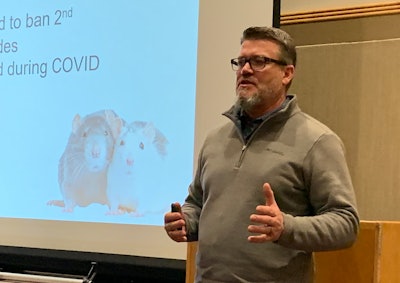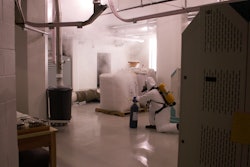As food safety demands intensify, it’s important not to forget your little furry friends—the mice and rats who are looking for a warm place to sleep and perhaps something to nibble on. One company hit upon its background in steel wool blends to create a rodent remediation that focuses on exclusion—keeping them out in the first place.
Founded in 1896 as American Steel Wool Manufacturing, Global Material Technologies (GMT) is the oldest and one of the largest steel wool manufacturing companies in the world. There are several different brands under the GMT umbrella, making all manner of steel fiber-based products from car brake liners to soap pads to filters.
Xcluder is one of the company’s more recent brand developments. Almost 20 years ago, GMT got an order from New York City for a trailer load of its steel wool blend, which was typically used for polishing glass, marble, and other surfaces. They shipped it off without giving it much thought until the city came back a year later to order another truckload.
“We called up the chief engineer that had ordered the product, and that individual told us that they were using our steel wool blend to plug holes in their subway system to keep rats and mice from coming into their subway system,” says Troy Bergum, Xcluder sales manager for GMT. “So, of course, light bulbs went off. We thought, what can we do with this? This is a very interesting opportunity. But we had to dive into how significant is this problem first.”
As it turns out, there was a significant problem with rats and mice getting into both residential and commercial structures, and steel fiber was a good base material for keeping those critters out. GMT launched its first residential door sweep to the pest management industry a year later. It wasn’t long before Xcluder had a range of products for commercial buildings as well, including fill fabric, and products to fill cracks, crevices, and holes coming into commercial buildings.
Bergum was at the Food Northwest Process and Packaging Expo in Portland, Ore., earlier this year to talk about the need for rodent control in the food and beverage industry.
ProFood World: You talk about holes coming into commercial buildings. What types of holes can rodents get into?
Bergum: What I mean by holes is conduit chases, so electrical chases coming in, HVAC lines, ammonia lines—all of these things that cause you to have penetration points coming into your building. A lot of times, what you see is a contractor will drill a 2-in. hole for a 1-in. conduit, put some spray foam in there, or nothing at all. None of those things are going to be a deterrent, especially if you don’t have anything in there, from the outside elements coming into your building.
There are products that are available in the marketplace that can really take care of the exterior of your building, and seal those openings against the unwanted infiltration of four-legged critters, rodents in particular, but also the environmental aspect of things—meaning outside elements like heat, humidity, cold temperatures, snow, salt, ice, sand, depending on what part of the country that you live in, or what part of the world you live in. There are also other outside contaminants, including bugs and things like that. With food-grade applications, in particular, you cannot afford to have the infiltration of any of these elements, because it goes against your food safety measures, it goes against the FDA establishments, and all the rules and regulations that are in place that you guys have to contend with every day as a food processor or manufacturer.
PFW: Your presentation at Food Northwest focused specifically on exclusion principles. Why is that so important?
Bergum: Something that most people don’t realize is that a mouse can fit through a hole the size of a dime, so your pinky finger. And a rat can fit through a hole the size of a quarter, so about the size of your thumb, or a little bit bigger than that. That’s the issue. And these guys are built to survive. They’re built to thrive and live in tough conditions. But all they need is food, water, and shelter.
And here’s the thing about how they operate. Mice and rats have scouts—usually the alpha male and female, a lot of times, will be the ones who are going to find shelter because they’re the protectors of the family. So they’re doing their thing, they’re scurrying around, their sense of smell is incredible, and they find an entry point into a building. They find out that it’s safe, that they can go in there, and they can get the stuff that they need. They will lay down a trail of pheromones—oils on their skin, urine, feces, all this type of stuff—that is now the roadmap for the rest of the clan that’s hanging out in your shrubs. ‘Hey, this is the entry point. Come on in, the smorgasbord is open, we got this.
Again, think about the hole the size of a dime or a quarter. It’s not easy to flush out, it’s not easy to find for you or me or anybody else, unless you’re really, really inspecting hardcore. Still, that’s the entry point. And if you don’t block off that entry point, they will continue to go into that entry point until you stop them from doing that. So here’s the kicker: You may seal off that entry point, but if you don’t seal off the entry point that’s 2 feet away from there, they will go to that one. They will know it’s around in that space where they’re very comfortable with going in, they know it’s safe.
That’s where exclusion comes into play—is to identify all of these cracks and crevices and door openings and all this type of stuff and put up that layer of defense on the exterior of your building, because that's where you’re getting invaded. There’s no doubt about that. I’ve had companies telling me, ‘Oh, we get some from the trailer that’s been transported to our facility.’ Not disagreeing with that; that certainly happens. But the masses in terms of the sheer numbers we know for a fact come from the exterior.
So leading rodentologists and pest control professionals all agree that exclusion is the best practice to put in place. It is really shocking to me the intelligence level that these animals have. They know how to avoid traps, they know how to avoid bait boxes, they know how to avoid glue boards—all of these things that pest management companies are telling you is the solution to try to take care of the problem. I’m not saying there’s anything wrong with those things because you have to address the interior side of things. But I’m just telling you, very simply put, that a lot of this stuff is not working anymore. That’s why exclusion continues to be hammered home. If any one of the pest management providers that you’re working with are not having that conversation with you, then they may not be as invested in your business as you think.
PFW: What have people typically used to seal off gaps they have in their infrastructure?
Bergum: The answer in the industry forever, since the industry began, is to install a brush weather seal on the bottom of the door or some sort of a vinyl flap, which is purely cosmetic. That's all it is. They may block off some air infiltration, potentially, depending on the thickness of the brush, or how hardy the vinyl seal is. But does it block anything else? The answer is no.
Unfortunately, there’s a misclaim out there that rats and mice don’t like the feel of brush weatherseal on their nose or their whiskers or their eyeballs. I was actually told that by an AIB [American Institute of Baking] inspector when I first got in the industry 20+ years ago that if you put brush weatherseal on a door, you don’t have to worry about rats or mice coming into that spot. Well, I found out about seven months later, as I saw a brush weatherseal destroyed by a rat, that that was not right. We have plenty of video examples of a very narrow crack with brush weatherseal protectant, and a rat blasting through that like it’s their day job—not only sliding right through it but also chewing a hole through it.
Here are the notorious bite marks. It doesn’t matter if it’s a rat or a mouse. If you see something that’s a halfmoon shape, from a chewing standpoint or an entry point, that is a rodent, guaranteed. What they’re doing is their nose is the pry bar—and their nose is actually kind of shaped like a crowbar. So they get their nose into a spot and they continue working with their nose and they can push something out of the way, and then get their teeth in there, and they’re working on that spot. If they’re undisturbed, they’ll work on that spot for hours.
They know that’s a vulnerability for your building. And they know what’s on the inside of that building is everything that they want. And again, all you need is a gap that’s a quarter of an inch. That’s it, they're coming in. You can have a gap on the bottom where two doors come together, but there could be a vertical gap here, too. You could seal off the bottom, but if you don’t worry about that seam going vertically, they will enter in that area. You know why? Because they’re used to coming into that spot, so they’re searching all vulnerabilities everywhere that they can within that general area where they have had success in terms of getting into a building, getting shelter, getting food, getting water.
PFW: How do Xcluder products help?
Bergum: How do you seal the bottom of the door? How do you seal the vertical seam on the door? We have solutions for that entire area. The fill fabric is at the core of our product. That’s what’s used in the roll form to fill cracks and crevices. You can put it around pipes, all those type of things.
People look at that and say, ‘Oh, that’s steel wool.’ No, it’s not steel wool. Steel wool is not effective in terms of sealing up any type of opening. Will it plug it? Yeah, I guess you could say that. But steel wool is very bulky, it doesn’t want to bunch up or anything like that. It’s very loose. If you stick it into a hole, it’s very easy to push out of the way for a rodent. No problem. Steel wool also has a certain odor to it that actually attracts rodents. Most people don’t know that. And when steel wool gets wet, it maintains moisture, it does not dry out very well. And it bleeds green. A green dye will come down the side of your house or the side of the building. It looks kind of nasty.
Our fill fabric is a polyester blend material. We use polyester because it’s very springy. You actually ball our material up, you can shove it into a hole, and poof, it expands and it locks into place. Polyester is also very breathable, so it does not maintain moisture. It does not wick up moisture. And then the magic sauce within the whole polyester blend is that we needle punch and weave core stainless steel fibers into that material. So if a rat or a mouse was to chew on it or nose into it, they’ve got a bad, bad surprise coming their direction.
When it comes to dock doors, ramp doors, things like that, we have that product. And then any one of the dock leveler components that are out there, any entry points we have on a dock leveler, and there are multiple… Again, this just kind of expands on the loading dock side of things, so we can seal the sides, we can seal the back, the pull chain plug goes in the holes on top of the deck, you have a dock door area so you can seal the side of the bottom leg and seal the sides of the door right across the top. That’s our complete exclusion solution for loading dock areas.



















